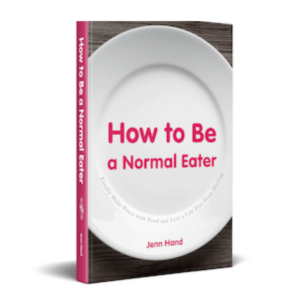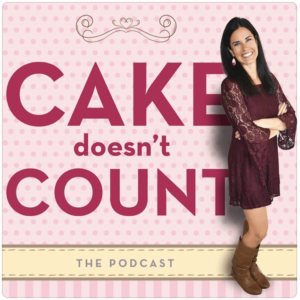Can you lose weight with intuitive eating?
Losing weight with intuitive eating is possible—but it’s not the primary goal. (But hear me out before you run away!)
With the intuitive eating approach, your weight may fluctuate as your body finds its natural set point. The focus is on healing your relationship with food, not controlling your body. When you practice intuitive eating, you learn to listen to hunger, honor fullness, and let go of the diet mentality, which lead to a gift greater than any number on the scale can provide: living a life free from food obsession.
Written by Jenn Hand, Holistic Nutritionist, Board Certified Health Coach, NBC-HWC
Understanding Intuitive Eating
Intuitive eating is an eating framework that helps you tune back into your body’s natural cues—like hunger, fullness, and satisfaction—rather than following external diet rules.
It was first created in the 1990s by two dietitians, Evelyn Tribole and Elyse Resch, who created the intuitive eating approach to help people break free from chronic dieting. At its core, intuitive eating is about rebuilding trust with your body and learning to hear your body’s signals, without judgment or restriction.
This means noticing your cravings, recognizing when you’re physically hungry, and stopping when you’re comfortably full.
Instead of obsessing over calories or “good” vs. “bad” foods, intuitive eating encourages a more compassionate and respectful relationship with food and your body.
Table of Contents
- My Experience with Intuitive Eating
- Can You Lose Weight with Intuitive Eating?
- How I Teach Intuitive Eating to My Clients (and Why It Works!)
- Sarah’s Intuitive Eating Success Story
- How Intuitive Eating Works
- The Must-Know Principles of Intuitive Eating
- What to Expect When You Start Intuitive Eating
- Can You Experience Weight Gain with Intuitive Eating?
- Signs of Physical Hunger vs Emotional Hunger and Why It Matters
- Intuitive Eating vs Mindful Eating
- Health Benefits Beyond the Scale
- The Research on Intuitive Eating and Weight
- Focusing on Healthy Eating and Body Acceptance
- Who to Work with for Healthy and Holistic Weight Loss
- Common Questions
My Experience with Intuitive Eating
When I first began to tackle my own food struggles, intuitive eating wasn’t yet mainstream.
I was working on some of the principles without knowing it was an actual guide for how to eat. I used to be obsessed with food—counting calories, swinging between bingeing and restricting, and always feeling like I was failing.
My mind was riddled with food rules and “shoulds.”
The diet mentality kept me trapped in a cycle of guilt and shame.
But when I started learning how to listen to my body, I slowly softened my rigid rules and started listening to what my body actually needed—which can be very scary at first!
It was a very windy journey.
I expected it to be a linear process, and it wasn’t!
There’s lots of fear to overcome when we learn to eat intuitively.
Dieting was such a part of my life that I was afraid I wouldn’t feel in control if I wasn’t dieting.
But slowly, I began to feel more at peace with food and learned, bit by bit, to trust myself in my food choices. Now, intuitive eating is how I live. It’s deeply ingrained in how I approach food—sometimes that looks like a big bowl of pasta, and other times it’s choosing a salad because that’s what sounds good!
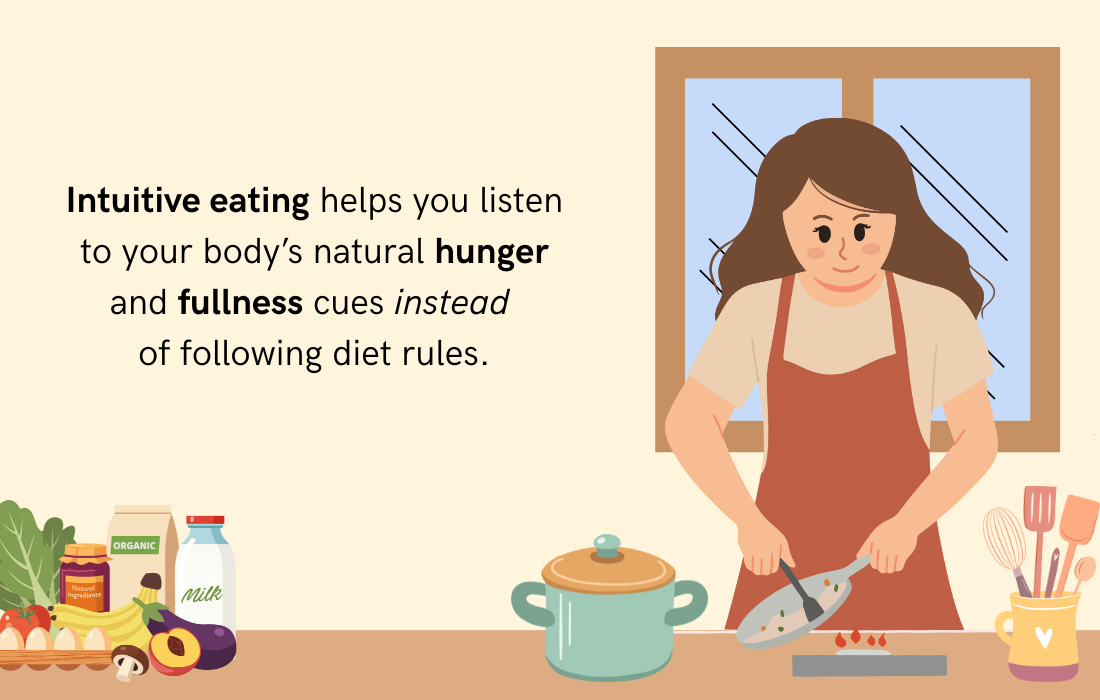
Can You Lose Weight with Intuitive Eating?
Intuitive eating doesn’t promise guaranteed weight loss. Here’s what it can do and may or may not do:
| What Intuitive Eating Can Do | What Intuitive Eating Doesn’t Promise |
|---|---|
| Help you rebuild trust with your body | Guaranteed weight loss |
| Reduce bingeing, emotional eating, and overeating | A specific number on the scale |
| Teach you to eat when you’re hungry and stop when you’re full | Rapid fat loss or quick results |
| Improve your relationship with food and your body | A structured diet or calorie-counting plan |
| Support long-term weight stability and wellbeing | Control over your body size or shape |
| Increase energy and reduce food obsession | A one-size-fits-all solution |
How I Teach Intuitive Eating to My Clients (and Why It Works!)
I take a little bit of a hybrid approach when working with clients.
For most people, intuitive eating is very far from where we start. If you’ve been dieting for years, it can be challenging to “just listen to your body.”
Most women usually don’t know what that means at first, and if they do, they might be afraid to listen!
So when I work with clients, we usually focus on adding protein to meals and eating every 3-4 hours. This builds a rhythm and routine with the body, so that we can begin to address the underlying emotional drivers to food and to begin to let go of some of the food rules that bog us down.
We also work through food triggers, learn how to recognize hunger and fullness cues, and soften the deep-seated diet mentality many of us carry. The reason this intuitive eating hybrid approach works is because it’s not about willpower or discipline.
Instead, it’s about curiosity, compassion, and consistency, with some gentle structure built in for support. Over time, the women I work with stop obsessing over food and start feeling more in control without needing control.
Sarah’s Intuitive Eating Success Story
When Sarah first came to me, she was exhausted from years of strict food rules, calorie counting, and constantly second-guessing everything she ate.
She was stuck in a cycle of being “good” during the week and then feeling out of control on weekends, followed by guilt and the pressure to start over again on Monday. The diet mentality had her convinced that any deviation from her plan was a failure.
Through the intuitive eating hybrid approach, she began to challenge the food police in her head and slowly gave herself permission to eat without guilt.
This was a practice, and it didn’t happen overnight!
She learned to recognize her physical hunger, check in with her fullness, and respond to emotions without always turning to food. Though there was a lot of fear to let go of, she did it bit by bit, to build trust over time.
She didn’t let go of food rules all at once.
Instead, she began with the food rules that felt easier to release and moved into more challenging ones as she gained trust. Now, Sarah says she feels free—she can go out to dinner without obsessing over the menu, enjoy dessert when she wants it, and no longer feels the need to “make up” for what she ate.
Her journey to eat intuitively wasn’t instant, but her improved mental health, confidence, and peace around food have been life-changing. She’s living proof that letting go of rigid rules doesn’t mean losing control—it means finally feeling at home in your body.

How Intuitive Eating Works
Intuitive eating is a gradual process of getting to know your body again.
It starts with letting go of the diet mentality and giving yourself permission to eat what your body wants and needs. Sometimes, this may be the forbidden food that we haven’t let ourselves eat in years, but this wears off over time.
From this space of permission, you learn to identify physical hunger, honor your fullness, and notice satisfaction in meals.
You begin to understand the difference between emotional and physical hunger, and learn tools to cope with emotions without always turning to food. The goal isn’t perfection—it’s to rebuild body trust and eat based on your own needs, not what a plan or diet tells you.
The Must-Know Principles of Intuitive Eating
Originally created by Evelyn Tribole and Elyse Resch, these 10 principles offer a solid foundation for anyone who wants to practice intuitive eating:
- Reject the diet mentality
- Honor your hunger
- Make peace with food
- Challenge the food police
- Feel your fullness
- Discover the satisfaction factor
- Cope with emotions without using food
- Respect your body
- Movement—feel the difference
- Honor your health with gentle nutrition
You don’t have to master them all at once, but each step helps you move toward a healthier, more balanced relationship with food.
In my approach, I combine intuitive eating and gentle structure, as that typically helps people build the bridge from dieting to learning to listen to their bodies.

What to Expect When You Start Intuitive Eating
Starting to eat intuitively can feel exciting—and also a bit scary.
After years of dieting, it’s normal to feel unsure or even overwhelmed. Some people fear weight gain, feel out of control around certain foods, or worry they’re doing it “wrong.” That’s because letting go of rules can feel like a loss of structure, and it takes time to rebuild trust with your body.
Many of my clients come in with the belief that intuitive eating is the “fix.”
They sort of view it as something to do “right.” In reality though, it’s not something you get right or wrong, it’s a process of unlearning all the baggage we picked up in the diet world and finding out what truly works for your body.
We learn through experimenting, getting feedback and tweaking to continue to find a way of eating that’s sustainable!
Can You Experience Weight Gain with Intuitive Eating?
Yes, it’s possible to gain weight—especially if your body has been underfed or restricted for a long time.
But weight gain isn’t a failure; it can actually be part of healing your metabolism and repairing your relationship with food.
Even though our mind wants the easy fix to lose weight, the goal of the intuitive eating approach isn’t weight loss—it’s to support your body in finding its natural set point and feeling its best. Over time, your weight stabilizes, and you’ll likely experience fewer food obsessions and more body trust.
Signs of Physical Hunger vs Emotional Hunger and Why It Matters
For many of us who’ve been dieting forever, physical and emotional hunger can be intertwined.
Learning how to tell the difference is key to honoring what our body needs. Physical hunger builds gradually, comes with bodily cues (like a growling stomach), and is satisfied by a range of foods.
Emotional hunger tends to come on suddenly, feels urgent, and usually involves cravings for specific comfort foods.
When you understand more deeply when you’re eating emotionally, this realization helps you explore how to meet your real needs, whether that’s food, rest, comfort, or connection. Recognizing these signals supports both better eating habits and stronger mental health.
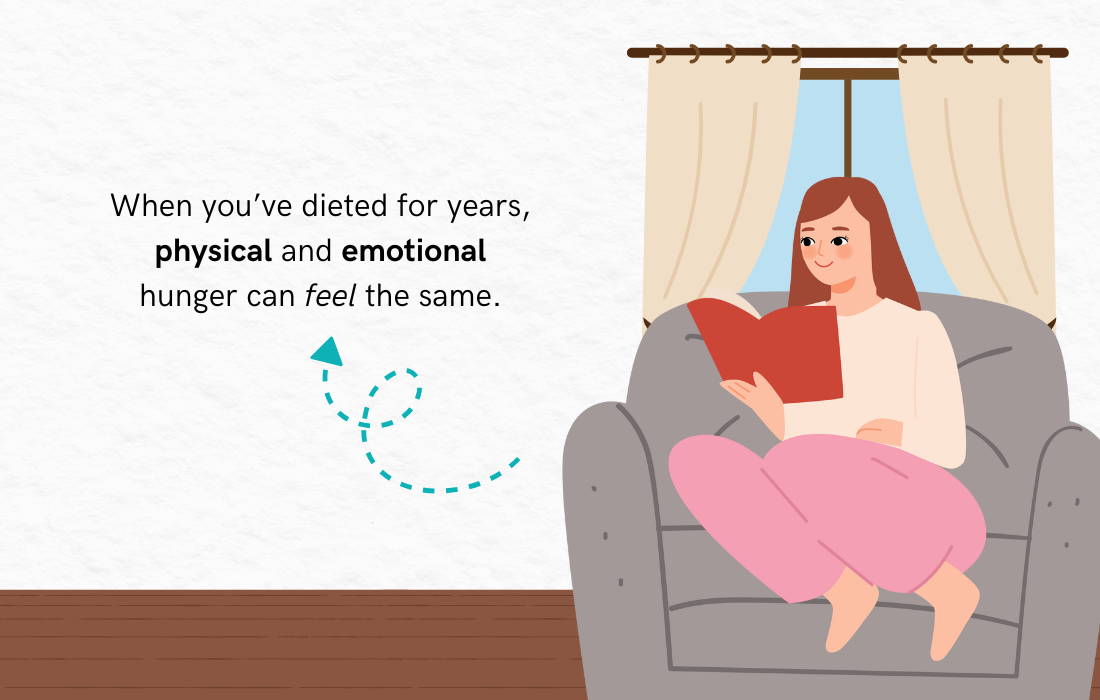
Intuitive Eating vs Mindful Eating
Mindful eating is about slowing down and being present during meals—paying attention to flavors, textures, and your body’s signals.
Intuitive eating, on the other hand, is a broader philosophy that includes mindfulness but also addresses emotional eating, the diet mentality, and the food police. Think of intuitive eating as the bigger picture, and mindful eating as one tool within that picture. Both help you reconnect to your body, but intuitive eating goes deeper into healing your relationship with food.
Health Benefits Beyond the Scale
The benefits of intuitive eating extend far beyond weight.
Research shows it can improve mental health, boost body image, reduce binge eating, and even lower stress levels. Many people also find they sleep better, have more energy, and experience fewer digestive issues.
For many of my clients, the first thing they notice is letting go of the food obsession. They think less about food during the day, get through multiple days without bingeing, and stop stressing out about their food choices.
The Research on Intuitive Eating and Weight
Current research on intuitive eating suggests it is more effective for weight maintenance than weight loss.
Cross-sectional studies consistently show intuitive eaters have lower BMI compared to non-intuitive eaters, especially among women and university students. Clinical studies, including randomized controlled trials, indicate intuitive eating supports weight maintenance, especially in overweight women, by reducing what researchers call weight cycling aka. yo-yo dieting.
But, evidence for significant weight loss is limited, with only two of eight clinical studies reporting weight reduction, both constrained by small sample sizes, short follow-ups, or lack of control groups.
Longitudinal studies reinforce that intuitive eating is associated with weight stability rather than gain, particularly in women, and reduces what scientists like to call “maladaptive eating behaviors” i.e. binge eating or overeating.
Some studies note intuitive eating may not directly improve physical health markers (e.g., blood pressure, glucose) beyond BMI effects, but it enhances psychological health, including self-esteem and body image. And it improves dietary quality.
Research also highlights that intentional weight loss pursuits may conflict with IE principles, which prioritize internal hunger and fullness cues over external diet rules.
Source 1 | Source 2 | Source 3 | Source 4 | Source 5
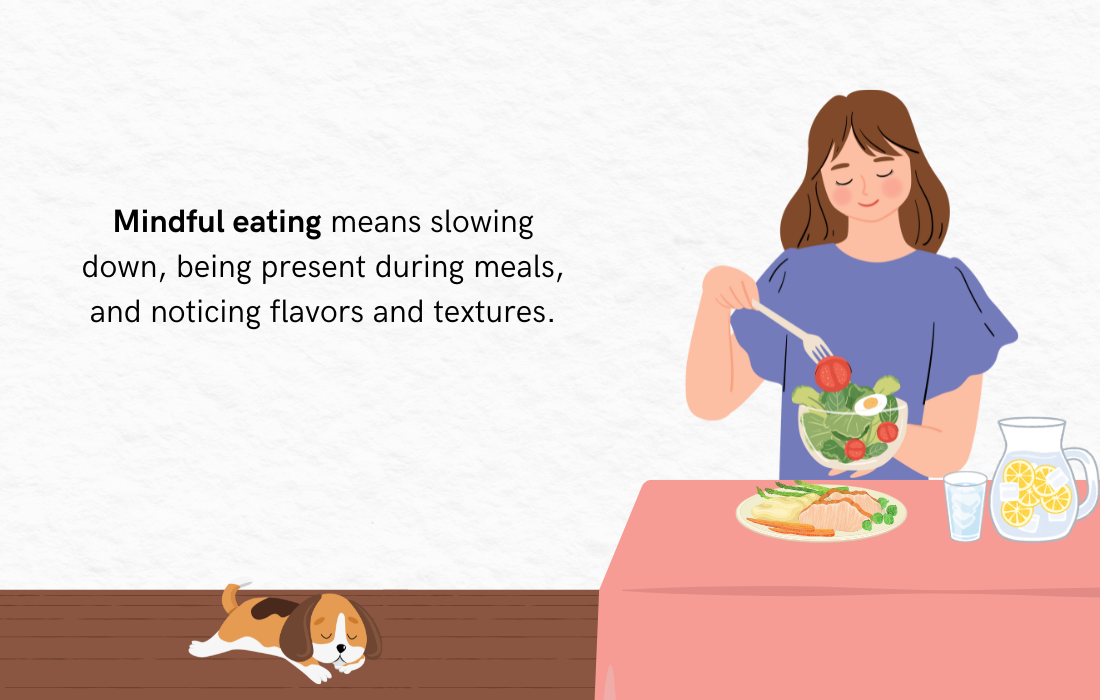
Focusing on Healthy Eating and Body Acceptance
It’s hard to let go of the focus on weight loss.
Instead of focusing solely on weight, try shifting your attention to how food makes you feel—energized, grounded, nourished. By practicing intuitive eating, you’re saying yes to honoring your body and no to the harmful standards of diet culture.
Body acceptance doesn’t mean you have to love every inch of yourself every day—but it does mean treating your body with kindness. This mindset helps you move toward peace with food and a healthier version of you—physically, emotionally, and mentally.
Who to Work with for Healthy and Holistic Weight Loss
If you’re struggling with bingeing, emotional eating, or chronic dieting, consider working with a certified intuitive eating counselor, a food coach, or an emotional eating coach.
These professionals are trained to guide you through the intuitive eating approach so you’re not figuring it out alone. They can help you break the cycle of shame and restriction and move toward true nourishment—both physically and emotionally. Healing is absolutely possible, and you don’t have to go it alone.
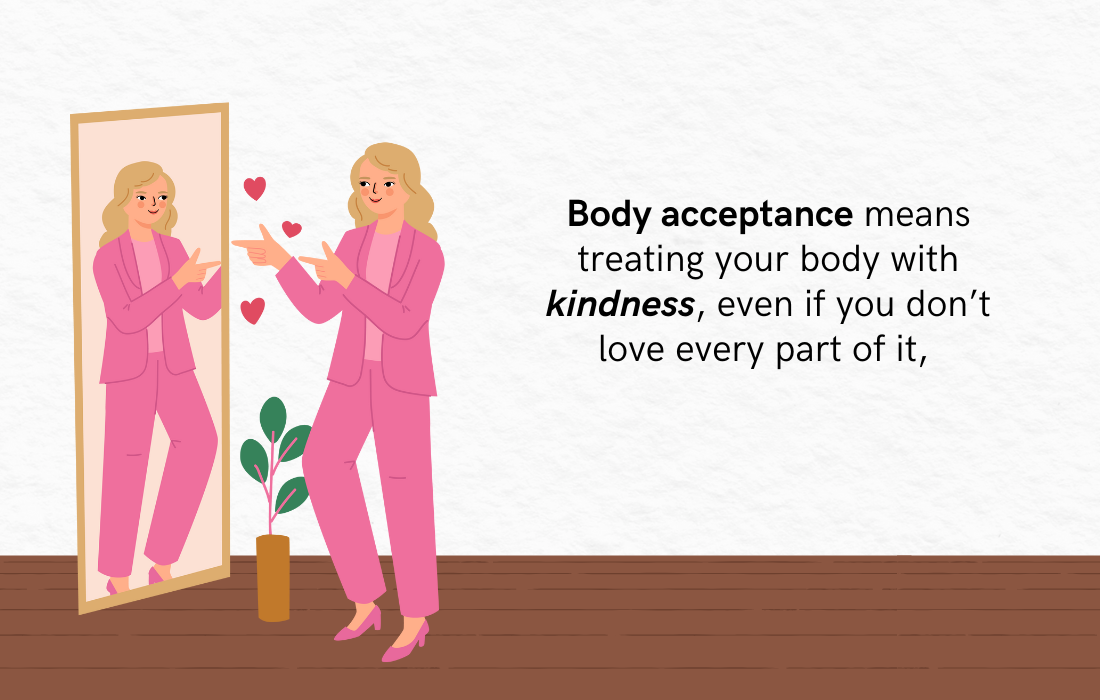
Common Questions
What is the difference between intuitive eating and mindful eating?
Mindful eating focuses on being present while you eat—slowing down, savoring, and tuning into hunger cues during meals.
Intuitive eating is a broader framework that includes mindfulness, but also emphasizes letting go of diet culture, honoring hunger, and healing your relationship with food.
How do I know if intuitive eating or mindful eating is right for me?
If you’re exhausted from the diet cycle and want to heal your food struggles, going deeper into why we eat, intuitive eating may be a better fit.
Mindful eating can be a great starting point if you’re simply looking to be more present and intentional at mealtimes.
Have you lost weight with intuitive eating?
Yes, but over a longer period of time.
My weight fluctuated 60 pounds while I was in the diet/binge cycle, so I spent years working on healing my relationship with food. More importantly than weight loss, learning to listen to myself helped me to gain was peace, trust in my body, and find freedom from food obsession—things no diet ever gave me.
How do you use intuitive eating for weight loss?
That’s our diet brain talking! You don’t “use” intuitive eating for weight loss—it’s not a weight-loss plan.
Some people do lose weight as a side effect of becoming more in tune with their body and letting go of binge-restrict cycles, but the goal is to learn to listen to your own body and make peace with food.
Will I gain weight if I start intuitive eating?
It’s possible to gain, lose, or maintain weight—it all depends on your body’s history and what it needs to find balance. Weight shifts are normal as your body adjusts.
How can I have a healthy relationship with food?
Start by letting go of guilt, getting curious about your habits, and tuning into your body’s signals instead of external rules.
Can intuitive eating help with “disordered eating habits?”
Yes—many people use intuitive eating as a tool to move away from restrictive or binge patterns and toward a more balanced, nourishing approach to food.
Related Articles
⚪ Holistic Weight Loss: What It Is and How It Works
⚪ How to Figure Out What to Eat So You Feel Nourished and Satisfied
⚪ 7 Tips for Coping with Food Cravings the Balanced Way
⚪ Intuitive Eating for Weight Loss Tips to Get You Started
Get the Normal Eater’s Newsletter
Join 8000+ women who are overcoming overeating, binge eating, and breaking up with dieting forever. Get Jenn’s inspiring and actionable weekly newsletter with the latest posts, podcasts, and tips on how to love your body, find food freedom, and lose weight holistically.
Get the Normal Eater’s NewsletterWork with an Emotional Eating & Holistic Nutrition Coach
Overcome Bingeing and Emotional Eating and Break Up with Yo-yo Dieting
Working with an emotional eating coach and holistic nutritionist can help you get free from the frustrating binge and restrict cycle and stop yo-yo dieting.
You don’t have to be obsessed with food or have a million rules around eating to find your natural weight and learn to love your body. Ready to actually see a lasting change and experience true freedom?
Schedule a 20-min CallAbout the Author:

Jenn Hand has been helping women like you become normal eaters since 2015.
She’s worked with thousands of women, helping them to balance their bodies, end bingeing, stop obsessing over food, and start feeling amazing again. As a board-certified health coach and holistic nutritionist, Jenn knows how to support you in making real positive changes that last.
Her articles have been published on Mind Body Green, Tiny Buddha, Thrive Global and other local and global media platforms. She’s the author of How to Be a Normal Eater and the creator of The Normal Eater’s Club program. Listen to Jenn’s advice and tips on the Cake Doesn’t Count Podcast, or read more of her articles for free on the Food Freedom Blog.
Learn About Coaching!


